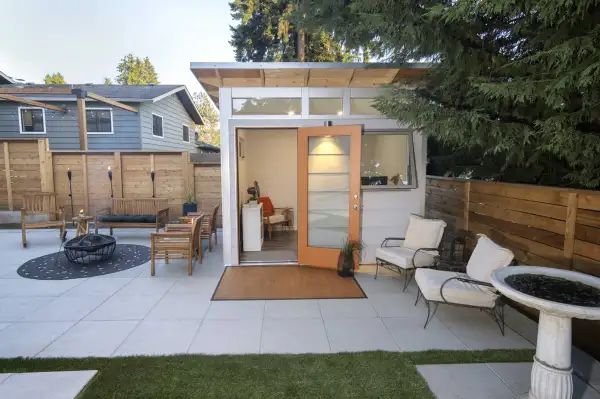'A Lifesaver for Our Sanity.' This Year's Hottest Home Renovations Are All About Finding More Space

Homeowners are finding creative ways to maximize their spaces — without resorting to a full-scale remodel or having to compete in a hot housing market.
Projects that add livable space are among the most popular on homeowners' wish lists for 2022, according to a recent survey by listing site Zillow. Adding or improvising an office space was top of the list with 31% of respondents saying they’d consider such a project. Finishing an attic or basement was another common choice (23%), as was adding an accessory dwelling unit (21%).
“The move for homeowners to optimize their space and create usable square footage has never been higher,” says David Steckel, home expert for Thumbtack.
These projects can not only expand the livable areas in a home but can also provide income. Finished basements with separate entrances and ADUs can not only be used as livable space but can also be used as income-generating additions either as long-term rentals or short-term rentals on platforms such as Airbnb.
Homeowners are making the most of indoor spaces
Jeff Neal was tired of his three kids using just about every room in the house as their personal playground through pandemic lockdowns. “It was driving me nuts,” he says.
His solution was to hire a contractor to turn his unfinished basement into usable space complete with extra storage and rubber gym mats to make the floor safe for the kids, who now have their own indoor playroom.
Like Neal, many homeowners have found that what they need from their space has changed during the pandemic. For some, this means buying and moving into larger homes or making costly extensions. For others, it means more modest interventions — maximizing their current home by transforming unfinished spaces or adding more square footage with an ADU or shed in the yard.
“People really are figuring out creative ways to use their homes more fully instead of trying to compete in all of these overheated real estate markets,” notes Jeremy Nova, co-founder and creative director of Studio Shed, a provider of prefabricated backyard structures.
Renovating an existing space in your home can be cost-effective compared to buying a new home. A basement that just requires some aesthetic touches, notes Steckel, can be accomplished with as little as $35 per square foot. A light remodel could be achieved with as little as $80 to $100 per square foot. A complete renovation that includes structural changes can cost over $150 per square foot. (Costs vary, of course, depending on your location and the scope of the work.)
Converting an attic to livable space, on the other hand, can be more costly, depending on whether insulation, flooring and drywall are already installed. Steckel estimates that costs for attic renovations, including a bathroom, average around $300 per square foot.
A competitive housing market is what led Brooke Grasley to finish the basement in her Joliet, Illinois home. After looking at homes for sale in her area, she and her husband realized that not only would they have to spend more money to buy a larger home, they would still have to spend money renovating it to fit their needs. Fixing up the basement to increase their livable area made more economic sense.
New spaces are being designed with flexibility in mind
Homeowners are not only looking to convert unused areas of the home but also create multifunctional spaces.
Bill Capece and his wife Jessica were already searching for a larger home when the pandemic hit in 2020. Among their requirements was a space that would serve as a studio for Jessica, who works as a brand expert on QVC, but could also be used as an entertainment area, an in-law suite or a rental unit.
After not finding a suitable home, they decided to renovate their basement during the summer of 2020. “We now have all of those options in a neighborhood that has always appreciated even through the last recession,” says Capece, who lives near Philadelphia.
The desire for multifunctionality has also led many homeowners to take a fresh look at their backyards and find ways of adding space without having to alter the structure of their homes.
ADU’s can be simple single-room studios or functional dwellings with a bathroom and kitchenette. Their popularity has steadily increased thanks to their flexibility — ADU’s can be used as a detached home office, a school learning pod, an art studio, a guest house or (if local laws allow) a rental unit that generates additional income.
“I think that’s one of the advantages and the attractiveness of it,” says Nova. “It’s a really flexible addition to a property.”
David Angotti, CEO of Hawaiianislands.com, installed an ADU in his backyard as a way of increasing storage space two years ago. When the pandemic hit and his family all started to work from home, the cramped quarters in the main home led Angotti to quickly convert a backyard storage space into an office. “It’s been a lifesaver for our sanity as well as our productivity,” notes Angotti.
The cost of ADU’s can vary depending on the size, as well as the features and finishes the homeowner asks for. A one-room studio can start at $30,000 while a complete dwelling could cost as much as $250,000. Nova estimates that a cost of $300-$400 per square foot would probably be valid in most major metro areas.
Tips if you’re considering adding space to your home
If you’re thinking of adding an ADU or finishing off a basement or attic space, your first step is to make a call to your building permits department to find out what changes you can legally make and what permits they may require. A simple phone call can save a lot of headaches further down the road.
Next, consider how much space you have and be realistic about how much of it you’ll actually need to meet your needs. Don’t be discouraged if you don’t have a lot of room to work with, either. Bigger, notes Nova, isn’t always better. Adding, “It’s amazing how functional a small space can be.”
Once you have an idea of how you want to optimize your space, whether by adding a backyard addition or repurposing an indoor space, shop around for the right designers and contractors to help bring your project to life. The right team will help you with permitting, sourcing materials and making sure the work is up to code.
“Acknowledge that you might not be an expert on this,” says Steckel. “Find a pro that wants to do your job and will be able to help you achieve the outcome that you’re hoping for.”
More from Money:
11 Major Real Estate Records Broken in 2021
5 Affordable Ways to Boost Your Home's Curb Appeal Before You Sell
Getting a New Home Move-in Ready Costs a Lot More Than You Think

